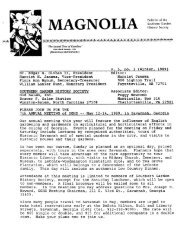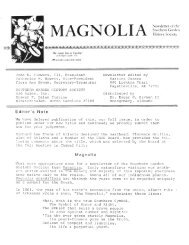Stanley W. Abbott: Visionary Planner of the Blue Ridge Parkway
Stanley W. Abbott: Visionary Planner of the Blue Ridge Parkway
Stanley W. Abbott: Visionary Planner of the Blue Ridge Parkway
You also want an ePaper? Increase the reach of your titles
YUMPU automatically turns print PDFs into web optimized ePapers that Google loves.
SGHS Annual Meeting……(continued from page 5)<br />
House and Point <strong>of</strong> Honor, followed by greater details on<br />
<strong>the</strong>ir work at Poplar Forest. A 1773 inheritance <strong>of</strong> 11,000<br />
acres and 135 slaves, Poplar Forest gave Jefferson <strong>the</strong> fiscal<br />
independence required for founding fa<strong>the</strong>r status. It later<br />
provided a place for retreat and creative architecturallandscape<br />
expression. His structural-grounds marriage<br />
achieved a unique five-part Palladian combination <strong>of</strong><br />
octagonal house, trees, and mounds. Jack Gary, Poplar<br />
Forest’s Director <strong>of</strong> Archaeology, honed in on <strong>the</strong> current<br />
restoration <strong>of</strong> Jefferson’s paper mulberry rows, which<br />
formed hyphens linking house to mounds. Archaeology<br />
has pinpointed tree sites, and it is now placing oval beds<br />
and “clumps” <strong>of</strong> trees once standing at <strong>the</strong> dwelling’s<br />
corners.<br />
Friday evening we were treated to tours and a gala<br />
dinner at Thomas Jefferson’s Poplar Forest. Each guest<br />
received a beautifully produced commemorative booklet<br />
celebrating three decades <strong>of</strong> <strong>the</strong> society. The keepsake,<br />
spearheaded by SGHS President Staci Catron and Vicepresident<br />
Carleton B. Wood, included <strong>the</strong> names <strong>of</strong> <strong>the</strong><br />
society’s founders, board members, publications, annual<br />
meeting coordinators and locations, and 117 charter<br />
members.<br />
Saturday’s opening program was especially germane<br />
to our meeting’s <strong>the</strong>me and locale: <strong>the</strong> life and garden <strong>of</strong><br />
Lynchburg native and Harlem Renaissance poet Anne<br />
Spencer. Reuben Rainey, William Stone Weedon Pr<strong>of</strong>essor<br />
Emeritus <strong>of</strong> landscape architecture, University <strong>of</strong> Virginia,<br />
spoke about <strong>the</strong> multitalented Spencer (1882-1975) who<br />
along with being a gifted poet and gardener was also a<br />
teacher, librarian, and civil rights activist. Rainey <strong>of</strong>fered a<br />
detailed preview <strong>of</strong> not only <strong>the</strong> Spencer garden, but also<br />
<strong>of</strong> her amazing cottage and writing retreat, “Edankraal.”<br />
Indicative <strong>of</strong> Spencer’s many famous visitors is an iron<br />
head from Ghana still to be found in her pond garden, a<br />
gift from W. E. B. Du Bois and named by Spencer “Prince<br />
Ebo.” Adding powerful impact to this presentation was<br />
Anne Spencer’s granddaughter, Shaun Spencer Hester,<br />
who delighted <strong>the</strong> audience by reading selections from her<br />
grandmo<strong>the</strong>r’s works and sharing insights into her life,<br />
garden, and poetry.<br />
Next, Ted Delaney highlighted ano<strong>the</strong>r spot in <strong>the</strong><br />
Lynchburg landscape that has gained fame well beyond <strong>the</strong><br />
region. The assistant director <strong>of</strong> <strong>the</strong> Old City Cemetery,<br />
Delaney reviewed <strong>the</strong> history <strong>of</strong> this burying ground,<br />
known in particular for its fine array <strong>of</strong> old roses, and<br />
explored what makes this Lynchburg landmark different<br />
from <strong>the</strong> later Victorian rural cemeteries and <strong>the</strong> history<br />
<strong>of</strong> <strong>the</strong> stewardship <strong>of</strong> <strong>the</strong> Sou<strong>the</strong>rn Memorial Association.<br />
Burials in this twenty-six acre site included a large area<br />
<strong>of</strong> “strangers,” many <strong>of</strong> whom were Irish immigrants and<br />
African Americans. Three-quarters <strong>of</strong> all those buried<br />
in <strong>the</strong> Cemetery, from 1806 to <strong>the</strong> present, are African<br />
American, both free and enslaved; more than one-third<br />
are infants and children under <strong>the</strong> age <strong>of</strong> four. The Ladies<br />
Memorial Association <strong>of</strong> Lynchburg formed after <strong>the</strong> Civil<br />
War to oversee <strong>the</strong> care and marking <strong>of</strong> <strong>the</strong> 2,000 plus<br />
Confederate graves. In <strong>the</strong> 1980s, four ladies who had<br />
recently “inherited” sole membership in <strong>the</strong> still-existing<br />
Sou<strong>the</strong>rn Memorial Association began <strong>the</strong> rehabilitation<br />
<strong>of</strong> <strong>the</strong> Confederate section. After a devastating wind<br />
storm in 1993, <strong>the</strong> ladies expanded <strong>the</strong> SMA stewardship<br />
to <strong>the</strong> entire cemetery. A plan by Rudy Favretti helped<br />
<strong>the</strong>m develop <strong>the</strong> area outside <strong>the</strong> Confederate section<br />
as an arboretum that included trees, shrubs, roses, and<br />
perennials that reflect nineteenth-century tastes. Today <strong>the</strong><br />
cemetery has become Lynchburg’s most visited historic<br />
site.<br />
The program continued with a presentation on<br />
Saunders Bro<strong>the</strong>rs Nursery by Paul Saunders and his son<br />
Bennett Saunders. Bennett gave a history <strong>of</strong> <strong>the</strong> nursery,<br />
which began as a partnership between five bro<strong>the</strong>rs in<br />
1915. By <strong>the</strong> 1930s, <strong>the</strong>y were growing mainly peaches<br />
and propagating boxwood. After his fa<strong>the</strong>r, Paul, took over<br />
Enjoying an evening at Pharsalia are: (standing L-R) Justin Stelter,<br />
Susan Inglis, Will Rieley, Bill Welch, and (seated) Frances Inglis<br />
and Staci Catron.<br />
6 Magnolia • Spring 2013 Vol. XXVI, No. 2<br />
Photo by Dean Norton
















